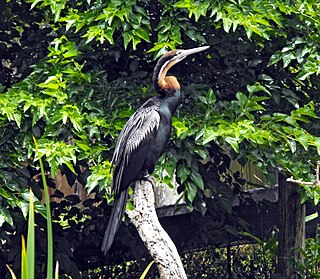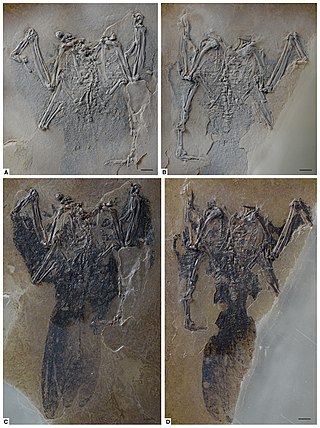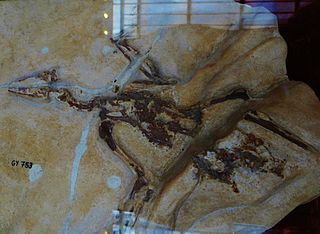
Barn-owls are one of the two families of owls, the other being the true owls or typical owls, Strigidae. They are medium to large owls with large heads and characteristic heart-shaped faces. They have long, strong legs with powerful talons. They also differ from the Strigidae in structural details relating in particular to the sternum and feet.

A phalarope is any of three living species of slender-necked shorebirds in the genus Phalaropus of the bird family Scolopacidae.

The darters, anhingas, or snakebirds are mainly tropical waterbirds in the family Anhingidae, which contains a single genus, Anhinga. There are four living species, three of which are very common and widespread while the fourth is rarer and classified as near-threatened by the IUCN. The term snakebird is usually used without any additions to signify whichever of the completely allopatric species occurs in any one region. It refers to their long thin neck, which has a snake-like appearance when they swim with their bodies submerged, or when mated pairs twist it during their bonding displays. "Darter" is used with a geographical term when referring to particular species. It alludes to their manner of procuring food, as they impale fishes with their thin, pointed beak. The American darter is more commonly known as the anhinga. It is sometimes called "water turkey" in the southern United States; though the anhinga is quite unrelated to the wild turkey, they are both large, blackish birds with long tails that are sometimes hunted for food.

The Coraciiformes are a group of usually colourful birds including the kingfishers, the bee-eaters, the rollers, the motmots, and the todies. They generally have syndactyly, with three forward-pointing toes, though in many kingfishers one of these is missing. The members of this order are linked by their “slamming” behaviour, thrashing their prey onto surfaces to disarm or incapacitate them.

The mousebirds are birds in the order Coliiformes. They are the sister group to the clade Eucavitaves, which includes the Leptosomiformes, Trogoniformes (trogons), Bucerotiformes, Piciformes and Coraciformes. This group is now confined to sub-Saharan Africa, and it is the only bird order confined entirely to that continent, with the possible exception of turacos which are considered by some as the distinct order Musophagiformes, and the cuckoo roller, which is the only member of the order Leptosomiformes, and which is found in Madagascar but not mainland Africa. Mousebirds had a wider range in the Paleogene, with a widespread distribution in Europe and North America during the Paleocene.

Opisthocomidae is a family of birds, the only named family within the order Opisthocomiformes. The only living representative is the hoatzin which lives in the Amazon and the Orinoco delta in South America. Several fossil species have been identified, including one from Africa and one from Europe.

Sagittariidae is a family of raptor with one living species—the secretarybird native to Africa—and a few fossil taxa.

The magpie goose is the sole living representative species of the family Anseranatidae. This common waterbird is found in northern Australia and southern New Guinea. As the species is prone to wandering, especially when not breeding, it is sometimes recorded outside its core range. The species was once also widespread in southern Australia but disappeared from there largely due to the drainage of the wetlands where the birds once bred. Due to their importance to Aboriginal people as a seasonal food source, as subjects of recreational hunting, and as a tourist attraction, their expansive and stable presence in northern Australia has been "ensured [by] protective management".

Anseranatidae, the magpie-geese, is a biological family of waterbirds. The only living species, the magpie goose, is a resident breeder in northern Australia and in southern New Guinea.

Strigogyps is an extinct genus of prehistoric bird from the Middle Eocene to Early Oligocene of France and Germany. It was probably around the size of a large chicken or a guan, weighing not quite 1 kilogram (2.2 lb). Apparently, as indicated by the ratio of lengths of wing to leg bones, S. sapea was flightless. Its legs were not adapted to running, so it seems to have had a walking lifestyle similar to trumpeters. Unlike other Cariamiformes, which appear to have been mostly carnivorous, Strigogyps specimens suggest a herbivorous diet.

Archaeotrogonidae is a prehistoric bird family known from the Eocene and Oligocene of Europe. They are members of Strisores, and are thought to be closely related to nightjars.

Créchy is a commune in the Allier department in central France.

Palaeortyx is an extinct genus of granivorous galliform bird that lived 28.4 to 2.588 million years ago. It lived from the early Eocene to the early Pliocene, and may be a phasianid or odontophorid. It is known from several fossils found in Germany, France, Italy, Hungary and Romania.
Hoazinavis is an extinct genus of early hoatzin from Late Oligocene and Early Miocene deposits of Brazil. It was collected in 2008 from the Tremembé Formation of São Paulo, Brazil. It was first named by Gerald Mayr, Herculano Alvarenga and Cécile Mourer-Chauviré in 2011 and the type species is Hoazinavis lacustris.
Elaphrocnemus is a genus of extinct bird from the Eocene and Oligocene periods of Europe. Part of Cariamiformes, its closest living relatives are seriemas, though it differs significantly from them, being a better flyer.
Chaunoides is an extinct genus of screamer. Only one species of this genus is known, namely Chaunoides antiquus.

Cécile Mourer-Chauviré is a French paleontologist specializing in birds of the Eocene and the Oligocene. In her early career, she discovered with her husband the Laang Spean cave site of prehistoric humans in Cambodia.
Pelargopappus is an extinct genus of raptor related to the secretarybird that lived in early Miocene France. Only one species, the type species P. magnus is officially recognized. A second species, P. schlosseri from the mid-and late Oligocene, was split off into the genus Amphisagittarius.

Eocoracias is an extinct genus of bird related to modern rollers and other Coraciiformes such as kingfishers, bee-eaters, motmots, and todies. It contains one species, Eocoracias brachyptera, and it lived approximately 47 million years ago based on dating of the fossil site. It is known for a specimen having preserved non-iridescent structural coloration on its feathers, previously unknown in fossil birds. Fossils have been found at the Messel Pit in Germany.














